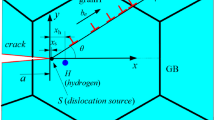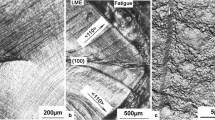Abstract
Using a special TEM constant deflection device, the change in dislocation configuration ahead of a loaded crack tip before and after adsorption of Hg atoms and the initiation of liquid metal-induced nanocracks (LMIC) have been observed. The results show that chemisorption of Hg atoms can facilitate dislocation emission, multiplication and motion. Nanocracks will be initiated in the dislocation-free zone (DFZ) or at the crack tip when chemisorption-facilitated dislocation emission, multiplication and motion reach a critical condition. On the basis of the available experimental evidence concerning liquid metal embrittlement (LME), a new mechanism for this phenomenon is considered. This involves the fact that the decrease in surface energy induced by chemisorption of Hg atoms results in a reduction in the critical stress intensity factors for dislocation emission and the resistance for dislocation motion. On the other hand, the plastic work andK IC will decrease with the decrease in the surface energy.
Similar content being viewed by others
References
Nicholas, M. G., Old, C. F., Liquid metal embrittlement,J. Mater. Sci., 1979, 14: 1.
Kelley, M. J., Stoloff, N. S., Analysis of liquid metal embrittlement from a bond energy viewpoint,Met. Trans., 1975, 6A: 159.
Lynch, S. P., Overview of evidence for an adsorption-induced localised-slip process,Acta Metall., 1988, 36: 2639.
Kargol, J. A., Albrighy, D. L., The effect of relative crystal orientation on the liquid metal induced grain boundary fracture of aluminum bicrystals,Metall. Trans., 1977, 8A: 27.
Bond, G. M., Robertson, I. M., Birnbaum, H. K., Environmentally assisted and fracture processes in high-purity aluminum,Acta Metall., 1988, 36: 2193.
Gu, B., Zhang, J. W., Wan, F. R.et al., Thein-situ TEM observation of corrosion facilitating dislocation emission and motion for brass,Scripta Metall. Mater., 1995, 32: 637.
Zhang, Y., Wang, Y. B., Chu, W. Y.et al., In-situ TEM observation of microcrack nucleation in titanium aluminide,Scripta Metall. Mater., 1994, 31: 279.
Westwood, A. R. C., Preece, C. M., Kamdar, M. H.,Fracture (ed. Liebowitz, H.), Vol. 3, New York: Academic Press, 1971, 589–644.
Ohr, S. M., An electron microscope study of crack tip deformation and its impact on the dislocation theory of fracture,Mater. Sci. Eng., 1985, 72: 1.
Hirth, J. P.,Theory of Dislocation, 2nd ed., New York: John Wiley, 1982.
Cherepanov, G. P.,Mechanics of Brittle Fracture, Moscow: Nauka, 1974.
Dewald, D. K., Lee, T. C., Robertson, I. M.et al., Dislocation structure ahead of advancing cracks,Scripta Metall., 1989, 3: 1307.
Sleeswyk, A. W.,Atomistics of Fracture (eds. Latanision, R. L., Pickens, J. R.), New York: Plenum Press, 1983.
Knott, J. F.,Fundamentals of Fracture Mechanics, London: Butterworths 1973.
Author information
Authors and Affiliations
Additional information
Project supported by the National Natural Science Foundation of China.
Rights and permissions
About this article
Cite this article
Su, Y., Wang, Y. & Chu, W. Chemisorption-facilitated dislocation emission and motion, and induced nucleation of brittle nanocrack. Sci. China Ser. E-Technol. Sci. 40, 661–669 (1997). https://doi.org/10.1007/BF02916852
Received:
Issue Date:
DOI: https://doi.org/10.1007/BF02916852




